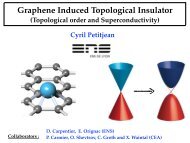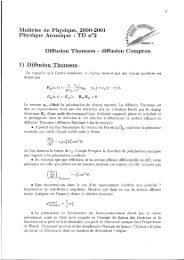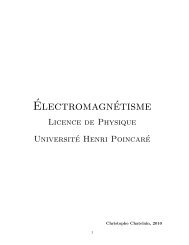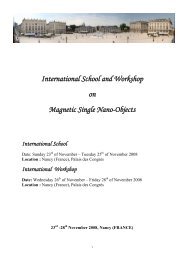Large inverse magnetoresistance in fully epitaxial Fe/Fe3O4 ... - LPM
Large inverse magnetoresistance in fully epitaxial Fe/Fe3O4 ... - LPM
Large inverse magnetoresistance in fully epitaxial Fe/Fe3O4 ... - LPM
Create successful ePaper yourself
Turn your PDF publications into a flip-book with our unique Google optimized e-Paper software.
<strong>Large</strong> <strong><strong>in</strong>verse</strong> <strong>magnetoresistance</strong> <strong>in</strong> <strong>fully</strong> <strong>epitaxial</strong> <strong>Fe</strong>/<strong>Fe</strong> 3O 4/MgO/Co<br />
magnetic tunnel junctions<br />
F. Greullet, 1,a� E. Snoeck, 2 C. Tiusan, 1 M. Hehn, 1 D. Lacour, 1 O. Lenoble, 1 C. Magen, 2<br />
and L. Calmels 2<br />
1<br />
Laboratoire de Physique des Matériaux, Nancy-Université, CNRS, B.P. 239, F-54506 Vandœuvre-lès-Nancy,<br />
France<br />
2<br />
Groupe NanoMatériaux, CEMES-CNRS, 29 Rue Jeanne Marvig, B.P. 4347, 31055 Toulouse, France<br />
�Received 18 October 2007; accepted 15 January 2008; published onl<strong>in</strong>e 8 <strong>Fe</strong>bruary 2008�<br />
Fully <strong>epitaxial</strong> <strong>Fe</strong>�001�/<strong>Fe</strong>3O4�001�/MgO�001�/Co micron-sized magnetic tunnel junctions have<br />
been elaborated on MgO�001� substrates. X-ray reflectivity and high-resolution transmission<br />
electron microscopy revealed a good quality and <strong>epitaxial</strong> growth of the stack with abrupt <strong>in</strong>terfaces.<br />
The magnetotransport measurements exhibit a large negative tunnel<strong>in</strong>g <strong>magnetoresistance</strong> �TMR�<br />
value for magnetic tunnel junctions <strong>in</strong>clud<strong>in</strong>g an <strong>Fe</strong>3O4 layer and a MgO tunnel barrier �−8.5% at<br />
300 K and −22% at 80 K�. Moreover, the sign of the TMR changes with the applied bias. We<br />
discuss here the structural quality of the samples and the transport measurement results. © 2008<br />
American Institute of Physics. �DOI: 10.1063/1.2841812�<br />
The discovery of a tunnel<strong>in</strong>g <strong>magnetoresistance</strong> �TMR�<br />
effect at room temperature �RT� <strong>in</strong> magnetic tunnel junctions<br />
�MTJs� with an amorphous oxide barrier 1,2 has <strong>in</strong>duced <strong>in</strong>tense<br />
developments with many possible application prospects<br />
�memory devices and sensors�. In particular, the role of<br />
the electronic structure of the electrodes and the <strong>in</strong>sulat<strong>in</strong>g<br />
barrier <strong>in</strong> the electron tunnel<strong>in</strong>g process has been at the core<br />
of experimental and theoretical efforts <strong>in</strong> electrode/<strong>in</strong>sulator/<br />
electrode systems. 3 The measurement of TMR values above<br />
200% at RT <strong>in</strong> <strong>Fe</strong>/MgO/<strong>Fe</strong> crystall<strong>in</strong>e oxide-based tunnel<br />
barriers 4–6 is the result of such <strong>in</strong>tense studies. Because of its<br />
high sensitivity to the electronic structure, the tunnel<strong>in</strong>g<br />
transport has also became an efficient tool to probe the density<br />
of states �DOS� of the collect<strong>in</strong>g electrode. Indeed, any<br />
change <strong>in</strong> the DOS <strong>in</strong>duces a specific electrical response of<br />
the system. Theoretical calculations performed on <strong>Fe</strong> 3O 4 reveal<br />
a half-metallic behavior at room temperature with 100%<br />
negative sp<strong>in</strong> polarization at the <strong>Fe</strong>rmi level. 7–9 Not to mention<br />
its high Curie temperature �T C=850 K�, this material is<br />
particularly <strong>in</strong>terest<strong>in</strong>g to <strong>in</strong>tegrate <strong>in</strong>to heterostructures such<br />
as MTJs because of its potentiality to exhibit large TMR<br />
values. However, at this stage, the properties of <strong>Fe</strong> 3O 4 rema<strong>in</strong><br />
controversial and may be l<strong>in</strong>ked to either the different<br />
growth methods or the <strong>Fe</strong> 3O 4 film thickness but with no real<br />
agreement between the different groups. For a complete<br />
review, see Ref. 17. In this study, <strong>epitaxial</strong><br />
<strong>Fe</strong>/<strong>Fe</strong> 3O 4/MgO/Co MTJs were grown. An<br />
<strong>Fe</strong>�001�/<strong>Fe</strong> 3O 4�001� bilayer was chosen as first electrode for<br />
its high stability and quality of the <strong>Fe</strong> 3O 4 layer grown on<br />
<strong>Fe</strong>�001� buffer. 10 It allows us to reach an <strong>Fe</strong> 3O 4 surface topography<br />
close to the s<strong>in</strong>gle-crystall<strong>in</strong>e one. To our knowledge,<br />
the reported TMR values for MgO-based MTJs us<strong>in</strong>g<br />
<strong>Fe</strong> 3O 4 electrodes have never exceeded 0.5% at RT. 11,12 Magnetotransport<br />
measurements performed on our high structural<br />
quality <strong>Fe</strong>/<strong>Fe</strong> 3O 4/MgO/Co micron-sized MTJs exhibit a<br />
large TMR ratio and a specific bias dependence never<br />
reported.<br />
a� Electronic mail: fanny.greullet@lpm.u-nancy.fr.<br />
APPLIED PHYSICS LETTERS 92, 053508 �2008�<br />
The <strong>Fe</strong>/<strong>Fe</strong> 3O 4/MgO/Co films were <strong>epitaxial</strong>ly grown<br />
on MgO�001� substrates by sputter<strong>in</strong>g <strong>in</strong> an UHV chamber<br />
whose base pressure is 10 −8 Torr. The <strong>Fe</strong> layer was deposited<br />
at RT us<strong>in</strong>g a magnetron system. The <strong>Fe</strong> 3O 4 was grown<br />
at 400 °C with a radio frequency power under a 5<br />
�10 −3 Torr Ar plasma pressure start<strong>in</strong>g from <strong>Fe</strong> 2O 3 fac<strong>in</strong>g<br />
targets which is reduced <strong>in</strong> the plasma. Then, MgO was<br />
grown at 100 °C and Co at RT. A Au capp<strong>in</strong>g layer was then<br />
deposited to protect the whole stack from oxidation. The<br />
flatness of each layer and the <strong>epitaxial</strong> relationship between<br />
them have been checked by <strong>in</strong> situ reflection high energy<br />
electron diffraction.<br />
We have elaborated different samples regard<strong>in</strong>g the<br />
thicknesses of the layers. Structural <strong>in</strong>vestigations performed<br />
us<strong>in</strong>g x-ray reflectivity �XRR� and high-resolution transmission<br />
electron microscopy �HRTEM� reveal no evidence of<br />
any change <strong>in</strong> the structural quality of the multilayer whatever<br />
the layer thicknesses are.<br />
The cross-sectional specimens for TEM studies were cut<br />
along the �100�MgO planes, glued face to face, then th<strong>in</strong>ned<br />
by mechanical gr<strong>in</strong>d<strong>in</strong>g and ion mill<strong>in</strong>g to the electron transparency.<br />
The structures of the different layers and <strong>in</strong>terfaces<br />
were <strong>in</strong>vestigated by TEM both <strong>in</strong> conventional and <strong>in</strong> highresolution<br />
mode us<strong>in</strong>g a FEI-F20 microscope fitted with a<br />
spherical aberration corrector whose po<strong>in</strong>t resolution is<br />
0.13 nm.<br />
Figure 1�a� shows a low magnification TEM bright field<br />
image of the multilayer. The <strong>in</strong>sulat<strong>in</strong>g barrier appears to be<br />
cont<strong>in</strong>uous over a long distance. A HRTEM micrograph of<br />
the stack<strong>in</strong>g is reported <strong>in</strong> Fig. 1�b� together with its correspond<strong>in</strong>g<br />
Fourier transform from �Fig. 1�c��. Both clearly<br />
evidence the good quality of the <strong>epitaxial</strong> growth separated<br />
by reasonably flat <strong>in</strong>terfaces. Table I gathers the lattice parameters<br />
and effective misfits �roughly not exceed<strong>in</strong>g 3%�<br />
between the neighbor<strong>in</strong>g relaxed layers. Co 1 and Co 2 notations<br />
depict the occurrence of two variants <strong>in</strong> the hcp Co<br />
layer, i.e., the hexagonal axis ly<strong>in</strong>g parallel to the <strong>in</strong>terface<br />
plane and be<strong>in</strong>g parallel to the �100� or �010� direction of<br />
MgO. This behavior has already been shown <strong>in</strong> previous<br />
studies. 13,14 The two variants for the total <strong>epitaxial</strong> relation-<br />
0003-6951/2008/92�5�/053508/3/$23.00 © 2008 American Institute of Physics<br />
92, 053508-1<br />
Author complimentary copy. Redistribution subject to AIP license or copyright, see http://apl.aip.org/apl/copyright.jsp
053508-2 Greullet et al. Appl. Phys. Lett. 92, 053508 �2008�<br />
FIG. 1. �a� Low magnification TEM bright field image of MgO�001�/<strong>Fe</strong>/<strong>Fe</strong> 3O 4/MgO/Co/Au. �b� HRTEM image of the same stack<strong>in</strong>g. �c� Fourier transform<br />
of the �b� HRTEM image.<br />
ship are, therefore, MgO-substrate�001��100��<strong>Fe</strong>�001�<br />
��110��<strong>Fe</strong> 3O 4�001��100��MgO�001��100��Co 1�11–20�<br />
��0001� and Co 2�11–20��1–100�.<br />
A Seifert �-2� x-ray diffractometer fitted with a double<br />
monochromator us<strong>in</strong>g the Cu K� radiation was used for<br />
XRR measurements. The experimental reflectivity profiles<br />
were simulated �Fig. 2� us<strong>in</strong>g the commercial software<br />
X’PERT REFLECTIVITY from PANalytical. This latter adjusts<br />
bulk density, thickness, and roughness of the def<strong>in</strong>ed layers.<br />
The extracted data are gathered <strong>in</strong> Table II. This experiment<br />
<strong>in</strong>dicates that the <strong>in</strong>terfaces of the whole stack are nearly flat<br />
especially at the <strong>Fe</strong> 3O 4/MgO and MgO/Co <strong>in</strong>terfaces �mean<br />
roughness of about 0.3 nm�. The density and thickness of the<br />
layers are <strong>in</strong> agreement with the expected ones.<br />
The high structural quality of the system brought us to<br />
perform magnetotransport measurements on <strong>Fe</strong> �12 nm�/<br />
<strong>Fe</strong> 3O 4 �8 nm�/MgO �2 nm�/Co �10 nm� multilayer. Thus,<br />
we have patterned the cont<strong>in</strong>uous layers <strong>in</strong>to micron-sized<br />
square-shaped MTJs us<strong>in</strong>g standard UV lithography and ion<br />
etch<strong>in</strong>g techniques. Investigations were made on about 20<br />
junctions with sizes rang<strong>in</strong>g from 10�10 to 40�40 �m 2<br />
and all have revealed the same behavior. The film thickness<br />
of <strong>Fe</strong> 3O 4 ��10 nm� was chosen to prevent the Verwey<br />
transition 15,16 when cool<strong>in</strong>g the sample. 17 Even if we have<br />
observed an <strong>in</strong>crease of the resistance-area product <strong>in</strong> our<br />
MTJs when decreas<strong>in</strong>g the temperature, it only doubles,<br />
pass<strong>in</strong>g from 64 M� �m 2 at 300 K to 128 M� �m 2 at<br />
80 K. Thus, this behavior shows that the 8 nm thick<br />
<strong>Fe</strong> 3O 4�001� preserves its metallic behavior when it is cooled.<br />
TABLE I. Effective misfits between adjacent layers.<br />
Crystal<br />
direction<br />
Lattice<br />
parameter �nm�<br />
Effective<br />
misfit<br />
MgO subst. �200� 0.21<br />
<strong>Fe</strong> �bcc� �110� 0.203 +3.3%<br />
<strong>Fe</strong> 3O 4 �fcc� �400� 0.21 −3.4%<br />
MgO �fcc� �200� 0.21 �1%<br />
Co 1 �hcp� �0002� 0.203 +3.3%<br />
Co 2 �hcp� �1–100� 0.19 +9.5%<br />
Figure 3 shows the TMR versus applied bias for a 10<br />
�10 �m 2 MTJ. As convention, <strong>in</strong> positive bias, the electrons<br />
flow from the <strong>Fe</strong>/<strong>Fe</strong> 3O 4 electrode through the Co counterelectrode.<br />
In negative voltage, the TMR decreases and reaches its<br />
maximum value at −0.2 V �−8.5% at 300 K and −22% at<br />
80 K�. In positive voltage, one can notice a rapid <strong>in</strong>crease of<br />
the TMR and a net change of its sign at 80 K at +0.3 V, this<br />
latter be<strong>in</strong>g more reserved at 300 K. At +0.6 V, the positive<br />
TMR achieves a maximum value �+5%�, as shown by the<br />
<strong>in</strong>set <strong>in</strong> Fig. 3.<br />
Interest<strong>in</strong>gly, our magnetotransport measurements depict<br />
an abrupt switch<strong>in</strong>g of the <strong>Fe</strong>/<strong>Fe</strong> 3O 4 bilayer at small applied<br />
magnetic fields �see <strong>in</strong>sets <strong>in</strong> Fig. 3�. This leads to a flat and<br />
endur<strong>in</strong>g plateau of 500 Oe where the <strong>Fe</strong> 3O 4 magnetization<br />
rema<strong>in</strong>s homogeneous. This behavior highlights improved<br />
magnetic properties of the <strong>Fe</strong> 3O 4 layer. Indeed, the <strong>Fe</strong> 3O 4<br />
magnetization has been previously reported to be hard to<br />
saturate because of the occurence of antiphase boundaries<br />
�APBs�. 17 Therefore, <strong>in</strong> our samples, we argue a drastic reduction<br />
of the APBs because of the abrupt switch<strong>in</strong>g of the<br />
soft bilayer followed by full saturation lead<strong>in</strong>g to a large<br />
operat<strong>in</strong>g field w<strong>in</strong>dow.<br />
Understand<strong>in</strong>g the specific bias dependence of the TMR<br />
rema<strong>in</strong>s difficult. The negative sp<strong>in</strong> polarization of the <strong>Fe</strong> 3O 4<br />
�Refs. 7–9� is widely accepted and has been experimentally<br />
proved for <strong>Fe</strong> 3O 4�001�. 18,19 Bataille et al. 20 have also found a<br />
FIG. 2. �Color onl<strong>in</strong>e� Experimental �black l<strong>in</strong>e� and simulated �red l<strong>in</strong>e�<br />
reflectivity profiles from the XRR measurement of a<br />
MgO�<strong>Fe</strong>/<strong>Fe</strong>3O4/MgO/Co/Au multilayer.<br />
Author complimentary copy. Redistribution subject to AIP license or copyright, see http://apl.aip.org/apl/copyright.jsp
053508-3 Greullet et al. Appl. Phys. Lett. 92, 053508 �2008�<br />
TABLE II. Density, thickness, and roughness of the layers extract from the<br />
simulation of XRR.<br />
Bulk<br />
density<br />
Simul.<br />
density<br />
Simul.<br />
thickness<br />
�nm�<br />
Simul.<br />
roughness<br />
�nm�<br />
<strong>Fe</strong> 7.83 7.75 11.9 0.5<br />
<strong>Fe</strong> 3O 4 5.18 4.76 7 0.25<br />
MgO 3.58 3.27 2 0.3<br />
Co 8.9 8.8 9.9 0.34<br />
Au 19.3 19.3 7.1 0.23<br />
negative sp<strong>in</strong> polarization at <strong>Fe</strong> 3O 4/�-Al 2O 3 us<strong>in</strong>g sp<strong>in</strong>resolved<br />
photoemission. However, their sp<strong>in</strong>-dependent tunnel<strong>in</strong>g<br />
experiments <strong>in</strong> <strong>Fe</strong> 3O 4/�-Al 2O 3/Co MTJ suggest a<br />
negative Co tunnel polarization. In our samples, accord<strong>in</strong>g to<br />
the negative TMR, a positive polarization of Co is suggested.<br />
Moreover, this polarization changes with applied voltage as<br />
shown by the change <strong>in</strong> sign of the TMR. The <strong>in</strong>fluence of<br />
the barrier on the sp<strong>in</strong> polarization of the tunnel<strong>in</strong>g current<br />
has already been highlighted by De Teresa et al. 21 In their<br />
study, the authors have demonstrated that the barrier can <strong>in</strong>duce<br />
a reverse of the tunnel<strong>in</strong>g current polarization. Our results<br />
show aga<strong>in</strong> that the relevant parameter to describe the<br />
sp<strong>in</strong> polarized transport <strong>in</strong> MTJs is the tunnel<strong>in</strong>g polarization<br />
and not only the electrode polarization. Furthermore, <strong>in</strong> MgO<br />
<strong>epitaxial</strong> based MTJs, the role of the barrier has already been<br />
demonstrated to be symmetry dependent. 6 This makes the<br />
analysis of transport us<strong>in</strong>g such a simple model impossible.<br />
Thus, to have a complete understand<strong>in</strong>g of the observed phenomenon,<br />
calculations on the <strong>in</strong>terfacial polarization for both<br />
<strong>Fe</strong> 3O 4/MgO and MgO/Co�hcp� are needed.<br />
In conclusion, we have demonstrate the high structural<br />
quality of <strong>Fe</strong>/<strong>Fe</strong> 3O 4/MgO/Co <strong>fully</strong> <strong>epitaxial</strong> MTJs grown<br />
on MgO�001� substrates. The magnetotransport measurements<br />
have revealed a negative TMR value of −22% at 80 K<br />
with a large and flat plateau of 500 Oe and a change of its<br />
sign <strong>in</strong> positive voltage. The strik<strong>in</strong>g behavior of the TMR<br />
with applied voltage cannot be understood without calculations<br />
on <strong>in</strong>terfacial tunnel polarizations. Moreover, this k<strong>in</strong>d<br />
of multilayer could be of great <strong>in</strong>terest <strong>in</strong> devices applications<br />
because of its rema<strong>in</strong><strong>in</strong>g TMR signal at f<strong>in</strong>ite bias.<br />
The authors would like to thank G. Lengaigne for technological<br />
process.<br />
1<br />
J. S. Moodera, L. R. K<strong>in</strong>der, T. M. Wong, and R. Meservey, Phys. Rev.<br />
Lett. 74, 3273 �1995�.<br />
2<br />
T. Miyazaki and N. Tezuka, J. Magn. Magn. Mater. 139, L231 �1995�.<br />
3<br />
W. H. Butler, X. G. Zhang, T. C. Schulthess, and J. M. MacLaren, Phys.<br />
Rev. B 63, 054416 �2001�.<br />
4<br />
S. S. P. Park<strong>in</strong>, C. Kaiser, A. Panchula, P. M. Rice, B. Hughes, M. Samant,<br />
FIG. 3. TMR vs bias curves <strong>in</strong> <strong>Fe</strong>/<strong>Fe</strong> 3O 4/MgO/Co MTJs at 300 K �open<br />
circles� and 80 K �full circles�. Inset: TMR vs field curves at 80 K for<br />
V=−0.2 V �−22% TMR� and V= +0.6 V �+5% TMR�.<br />
and S. H. Yang, Nat. Mater. 3, 862�2004�.<br />
5 S. Yuasa, T. Nagahama, A. Fukushima, Y. Suzuki, and K. Ando, Nat.<br />
Mater. 3, 868 �2004�.<br />
6 C. Tiusan, F. Greullet, M. Hehn, F. Montaigne, S. Andrieu, and A. Schuhl,<br />
J. Phys.: Condens. Matter 19, 165201 �2007�.<br />
7 A. Yanase and K. Siratori, J. Phys. Soc. Jpn. 52, 312 �1984�.<br />
8 R. A. de Groot and K. H. J. Buschow, J. Magn. Magn. Mater. 54, 1377<br />
�1986�.<br />
9 Z. Zhang and S. Satpathy, Phys. Rev. B 44, 13319 �1991�.<br />
10 N. Spiridis, J. Barbasz, Z. Lodziana, and J. Korecki, Phys. Rev. B 74,<br />
155423 �2006�.<br />
11 X. W. Li, A. Gupta, G. Xiao, W. Qian, and V. P. Dravid, Appl. Phys. Lett.<br />
73, 3282 �1998�.<br />
12 P. J. van der Zaag, P. J. H. Bloemen, J. M. Ga<strong>in</strong>es, R. M. Wolf, P. A. A.<br />
van der Heijden, R. J. M. van der Veerdonk, and W. J. M. de Jonge, J.<br />
Magn. Magn. Mater. 211, 301 �2000�.<br />
13 H. Wormeester, E. Hüger, and E. Bauer, Phys. Rev. Lett. 77, 1540�1996�.<br />
14 J. Faure–V<strong>in</strong>cent, Ph.D. thesis, Université Henri Po<strong>in</strong>caré, Nancy, 2004.<br />
15 E. J. W. Verwey, Nature �London� 144, 327�1939�.<br />
16 E. J. W. Verwey, P. W. Haayman, and F. C. Romeijn, J. Chem. Phys. 15,<br />
181 �1947�.<br />
17 A. M. Bataille, Ph.D. thesis, Université Paris-XI, Orsay, 2005.<br />
18 D. J. Huang, C. F. Chang, J. Chen, L. H. Tjeng, A. D. Rata, W. P. Wu, S.<br />
C. Chung, H. J. L<strong>in</strong>, T. Hibma, and C. T. Chen, J. Magn. Magn. Mater.<br />
239, 261 �2002�.<br />
19 S. A. Morton, G. D. Waddill, S. Kim, I. K. Schuller, S. A. Chambers, and<br />
J. G. Tob<strong>in</strong>, Surf. Sci. 513, L451 �2002�.<br />
20 A. M. Bataille, R. Mattana, P. Seneor, A. Tagliaferri, S. Gota, K.<br />
Bouzehouane, C. Deranlot, M. J. Guittet, J. B. Moussy, C. de Nadaï, N. B.<br />
Brookes, F. Petroff, and M. Gautier–Soyer, J. Magn. Magn. Mater. 316,<br />
e963 �2007�.<br />
21 J. M. De Teresa, A. Barthélémy, A. <strong>Fe</strong>rt, J. P. Contour, R. Lyonnet, F.<br />
Montaigne, P. Seneor, and A. Vaurès, Phys. Rev. Lett. 82, 4288 �1999�.<br />
Author complimentary copy. Redistribution subject to AIP license or copyright, see http://apl.aip.org/apl/copyright.jsp








